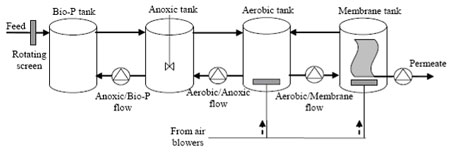Municipal wastewater treatment plants continue to adopt submerged membrane bioreactor (MBR) technology due to two advantages over conventional biological wastewater treatment-improved effluent quality and a smaller footprint. When coupled with membranes, biological and chemical phosphorous removal methods can be employed to meet total phosphorous effluent limits of less than 0.1 mg/L. Phosphorus precipitation, combined with the positive barrier the membrane provides, reduces the amount of phosphorus and suspended solids in the plant effluent.
Controlling phosphorous discharge is key to preserving surface water quality. Today, new legislation and regulations strictly limit phosphorous discharge into sensitive waters. Typically, conventional phosphorus removal processes using biological and tertiary treatment steps are capable of providing effluent total phosphorous levels in the range of 0.5 to 1 mg/L.
Conventional Biological Removal
The biological removal process uses phosphorous accumulating organisms (PAOs) in an alternating anaerobic/aerobic environment. An anaerobic environment, combined with the presence of adequate volatile fatty acids (VFA), promotes the release of stored phosphorous by the microorganism. An aerobic environment subsequently promotes the "luxury uptake" of phosphorous by the PAOs.
Simply stated, the process involves stressing the bacteria in the anaerobic zone (absent nitrate and oxygen), causing the release of phosphorus. New bacteria are formed, using the phosphorus that was previously released in the anaerobic zone and extra phosphorus returned to the cells' mass. The additional phosphorus removed by the bacteria is commonly referred to as a "luxury uptake" of the phosphorus.
Conventional Chemical Removal
Chemical phosphorous removal can be employed as an alternative method or as a supplemental treatment downstream of the biological removal process; however, the biological process has the advantages of reduced chemical costs and less sludge production.
In a chemical removal process, metal salts are added to combine with the various forms of phosphorus, forming an insoluble precipitate. Aluminium sulphate (alum), calcium (lime) and ferric chloride (ferric) are metal salts commonly used for chemical removal of phosphorus.
Advantage of MBR
Conventional gravity clarification and filtration separation methods fail to remove all biological and chemical solids, thus allowing phosphorus to pass into treated water. Membranes provide a physical barrier that captures nearly all of the suspended solids. Membrane filtration is used as the liquid solids separation method in a MBR to capture solids and results in a low level of phosphorous in the treated water.
Pilot Study
A pilot study conducted by a provider of consulting, engineering and construction services to the water/wastewater, transportation, environmental and facilities markets examined the nitrogen and phosphorus removal capabilities of MBR for a wastewater treatment plant from January to June 2007. Specifically, the study considered MBR's ability to meet the stringent effluent quality requirements (Figure 1) anticipated in the future by operating a system at a mixed liquor suspended solids concentration of 10,000 ppm.
Figure 1

The MBR pilot system employed submerged membrane technology. The system is a second generation MBR module design that employs reinforced hollow fibers. Unlike the first generation "double header" design that fixes both ends of the hollow fibers at the top and the bottom, the new system has no top header that can trap hair and other fibrous debris and cause clogging of the membrane module. Instead, the tips of the hollow fiber membrane are allowed to move freely with a seaweed-like action.
The design directs low pressure air to the center of each fiber bundle where it effectively scours the entire membrane bundle from the base to the membrane tips. This air scour feature creates coarse bubbles that shake the membrane and clean the outside of the hollow fibers, removing accumulated debris. An effective air scour method is used that allows for a cyclical air supply, reduces energy consumption and diminishes sludging in the membrane fibers.
The pilot study employed a biological phosphorous removal process that used anaerobic, anoxic and aerobic zones prior to the solids separation step performed by the membrane module. A chemical removal process could have been added prior to the membrane if additional phosphorous removal was required; however, the pilot study omitted this step (Figure 2).
Figure 2

The pilot system demonstrated nutrient removal capability that meets or exceeds regulatory limits. The system reduced total phosphorus from 8 mg/L to 0.04 mg/L, with the addition of acetic acid to the anaerobic zone. The supplemental acetate was required to boost the BOD/P ratio to the optimal performance conditions of between 10 and 25 BOD/P (Figure 3).
Reducing the solids retention time (SRT), commonly referred to as sludge age, was also critical in the pilot study. Monitoring the SRT is important in managing phosphorus removal, because as the SRT increases, the microbes age and perish, releasing the contents of their cell mass (including some phosphorus) into solution.
Conclusion
The pilot study demonstrates that lower effluent phosphorus levels can be achieved with an MBR system when compared to the conventional biological removal process. Municipal wastewater treatment plants might consider submerged membrane bioreactor technology for its phosphorous removal capabilities, on top of other benefits like improved COD and BOD reduction and greater treatment capacity within a small footprint.
Submerged membrane bioreactor technology may play an increasingly important role in phosphorous removal as municipal treatment plants address increasingly stringent discharge limits.
Pumps & Systems, October 2009


